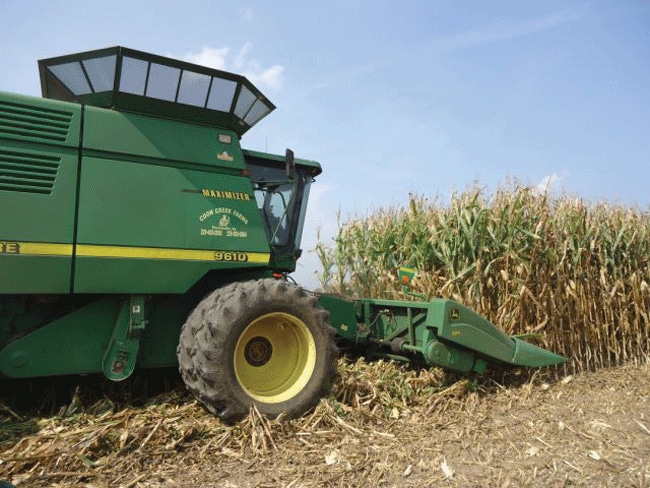November 12, 2012

Corn will drive the commodity markets, soybeans will help to make things interesting, and there’s always the chance of a margin squeeze next year, predicts Todd Davis, senior economist with the American Farm Bureau.
“It appears likely that continued strong worldwide demand for corn and soybeans will lead to higher projected prices,” said Davis at the recent Southern Region Agricultural Outlook Conference held in Atlanta.
You can check current commodity prices now.
The October balance sheet from the World Agricultural Outlook Board shows a U.S. harvested corn acreage for 2012 of 87.4 million acres with an average yield of 122.8 bushels per acre, down 24.4 bushels from last year.
Last year’s yield was down 5.6 from the previous year, and 2010 was down 12 bushels from 2009, says Davis. “We see a trend, and it’s not going in the right direction.”
Carry-in stocks are estimated at 1.18 billion bushels, the lowest level since 2004-2005, while USDA estimates production at 10.7 billion bushels.
“Imports will be up, but as a country, we’re exporters by nature,” says Davis. “We’re very efficient at pushing this stuff out the door, but we’re not as efficient in unloading these large vessels and barging it up the river.”
The U.S. will be at the lowest level for feed use since 1988-89, and exports will be the lowest since 1985-86, he says. “That’s what you get when you have demand rationing. If you don’t have the corn, then you can’t export it.”
Corn ending stocks, as of October, were estimated at 733 million bushels, representing 24 days of supply. The projected range for the corn season-average farm price was forecast at $7.20 to $8.60 per bushel. “If a mid-point of $7.90 is achieved, it’ll be a record, up $1.65 from the old crop marketing year,�” says Davis.
The stocks-to-use ratio is 6.5 percent, with 5 percent considered the pipeline minimum, he says. “So there’s not a lot of cushion there for further reductions in production with this crop.
“The 2011-2012 crop had a beginning balance sheet of 1.1 billion bushels, and we had to do supply rationing . We’ve been in a rationing mode for the last couple of years. The concern is that once we get our stocks built up, how long will it take for this demand to recover?”
In the 2011-12 marketing year, says Davis, feed and exports took the brunt of the reduction, and ethanol was barely scathed, down by about 21 million bushels. This year, because of the very small crop, USDA is projecting ethanol demand to be reduced by 5 to 10 million bushels from the previous year.
“Prior to 2006, planted corn acreage was 77 to 79 million, and then we had the big increase related to the growth in demand on the renewable fuel side.
Marginal land going into production
“We’re pushing the Corn Belt up into the Dakotas and down into Kansas, into production land with lower-than-average trend yields. We’re getting marginal land into corn production.”
According to the 20-year corn yield trend, the U.S. has been below trend for six out of the last seven years, says Davis.
“It makes sense because we’re adding a lot of new land. Last year, we were a little below 9 percent from trend, and in 2010, about 5 percent below trend. The South had fairly good corn yields, if your expectation is trend. In the Southern region, if you have a crop, you have great prices to take advantage of.”
USDA is projecting China to import nearly 750 million bushels of corn, says Davis.
“Corn stocks will be very tight, and we’re looking at stocks-to-use below 6 percent. On a global basis, corn stocks have declined from the previous year, and on a stocks-to-use basis, we’re at some of the tightest levels we’ve ever seen. We just don’t have a lot of cushion in the balance sheet to withstand further production cuts.”
Looking ahead to next year, if U.S. producers increase corn acres and make a good yield, there is the potential for building stocks, lowering the price, and having the traditional margin squeeze that hasn’t been experienced in corn production in about five years, says Davis.
On the other hand, continuing drought conditions could keep stocks relatively tight, he adds.
“All eyes are on South America as spring begins,” says Davis. “Weather remains a major factor for crops in both North and South America.”
An El Niño weather event is needed to help break the current U.S. drought, says Davis, and some climatologists are now saying that El Niño is weak.
“A strong El Niño will bring more rain to South America — something USDA already has in its projections — and it also increases the likelihood of breaking the Midwest drought.”
Looking at droughts from 1890 to the present, the shortest drought was 18 months, and the current U.S. drought began in July, says Davis.
“So if the past is indicative of the future, the current drought could increase into the next crop year. The 1930s and 1950s droughts were 51 and 47 months long, respectively.”
If U.S. producers increase corn acres and get a good yield in 2013, there is the potential for building stocks, lowering the price, and having the traditional margin squeeze, he says.
“We haven’t experienced that on the corn side for the last five years. But we could be back in the game of cost of management and tight margins.”
About the Author(s)
You May Also Like




